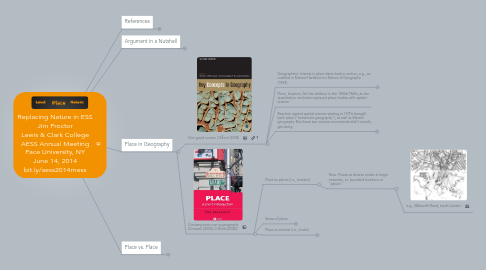
1. References
1.1. Clifford, Nicholas. 2008. “Place: Connections and Boundaries in an Interdependent World.” In Key Concepts in Geography, edited by Nicholas Clifford, Sarah Holloway, Stephen P. Rice, and Gill Valentine, 153–72. SAGE Publications Ltd.
1.2. Cresswell, Tim. 2004. Place: A Short Introduction. Malden, MA: Blackwell.
1.3. Entrikin, J. Nicholas. 1991. The Betweenness of Place: Towards a Geography of Modernity. Macmillan.
1.4. Hartshorne, Richard. 1939. The Nature of Geography. Lancaster, PA: Association of American Geographers.
1.5. Massey, Doreen. 1991. “A Global Sense of Place.” Marxism Today 35 (6): 24–29.
1.6. Orr, David W. 1992. Ecological Literacy: Education and the Transition to a Postmodern World. SUNY Press.
1.7. Sack, Robert David. 1992. Place, Modernity, and the Consumer’s World: A Relational Framework for Geographical Analysis. Johns Hopkins University Press.
2. Argument in a Nutshell
2.1. 1. Environmental thought and action have been constrained by our very notion of "the environment" (i.e., natural systems dynamics/human impacts).
2.2. 2. Environment as "that which surrounds" is better approached via the concept of place, as considered by geographers for nearly a century.
2.3. 3. Replacing nature would not replace the ESS curriculum, but it would reorient it by situating related topics & systems in the geographical contexts where they actually take place. [Image courtesy Shirley Vincent, NCSE]
3. Place in Geography
3.1. One good source: Clifford (2008)
3.1.1. Geographers' interest in place dates back a century, e.g., as codified in Richard Hartshorne's Nature of Geography (1939).
3.1.1.1. Hartshorne (and early geography): World as mosaic of bounded places/regions
3.1.1.1.1. ...e.g., France?...
3.1.1.2. Each place a unique assemblage (idiographic vs. nomothetic)
3.1.1.3. Geography does "areal differentiation" of these unique places/regions
3.1.1.4. Note: From the beginning, biophysical processes an important part of place/region analysis, but always situated in human interpretation/use/impacts.
3.1.2. Place, however, fell into disfavor in the 1950s/1960s, as the quantitative revolution replaced place studies with spatial science
3.1.3. Reaction against spatial science starting in 1970s brought back place ("humanistic geography"), as well as Marxist geography. But these two counter-movements didn't exactly get along.
3.1.3.1. Humanistic geography: Emphasis on sense of place
3.1.3.2. Marxist geography: "Sense of place" ignores larger political-economic structures that enable/constrain places (space vs. place)
3.1.3.3. Both perspectives incorporated into contemporary use of place in geography
3.1.3.3.1. Doreen Massey "A global sense of place" (1991), p. 29: "…It is a sense of place, an understanding of 'its character', which can only be constructed by linking that place to places beyond. A progressive sense of place would recognise that, without being threatened by it. What we need, it seems to me, is a global sense of the local, a global sense of place."
3.2. Contemporary use in geography (Creswell [2004]; Clifford [2008])
3.2.1. Place as places (i.e., location)
3.2.1.1. Now: Places as diverse nodes in larger networks, vs. bounded locations or "places"
3.2.1.1.1. e.g., Walworth Road, south London
3.2.2. Sense of place
3.2.2.1. Now: "Glocal" identities, construction of authenticity, etc.
3.2.2.1.1. e.g., sense of place in Europe
3.2.3. Place as context (i.e., locale)
3.2.3.1. Now: Uneven/restless (& still hybrid) geographies
3.2.3.1.1. e.g., place, modernity, and mass consumption (Sack 1992)
3.2.3.1.2. One particular view from somewhere!
4. Place vs. Place
4.1. ESS
4.1.1. David Orr, Ecological Literacy (1992) p. 88-9: "Ecological literacy is becoming more difficult, I believe, not because there are fewer books about nature, but because there is less opportunity for the direct experience of it.…A sense of place requires more direct contact with the natural aspects of a place, with soils, landscape, and wildlife."
4.1.2. Scale: Local ("sense of place")
4.1.3. Emphasis: Humans-in-nature
4.2. Geography
4.2.1. Nicholas Entrikin, The Betweenness of Place (1991) p. 5: "To understand place requires that we have access to both an objective and a subjective reality. From the decentered vantage point of the theoretical scientist, place becomes either location or a set of generic relations and thus loses much of its significance for human action. From the centered viewpoint of the subject, place has meaning only in relation to an individual's or a group's goals and concerns. Place is best viewed from points in between."
4.2.2. Scale: Glocal ("local" and "global" are fictions)
4.2.3. Emphasis: Places as hybrid constructions ("nature" and "culture" are fictions)
4.3. Where go with these differences?
4.3.1. Andrew Revkin: "Variegation is our friend"
4.3.2. JDP: Place is too important in ESS—and in the Anthropocene—to shortchange.
